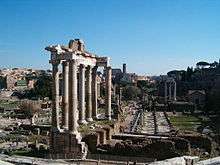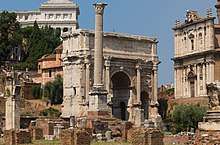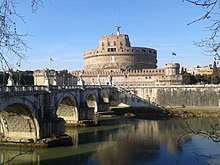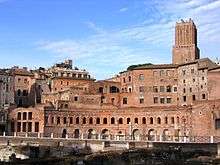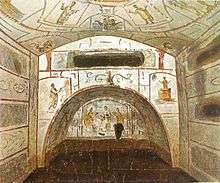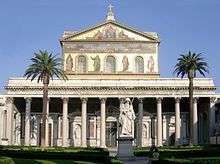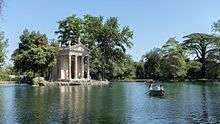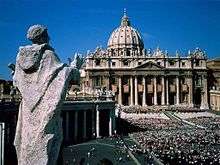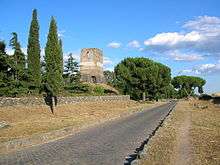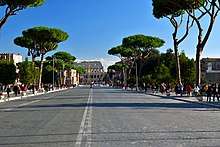Outline of Rome
The following outline is provided as an overview of and topical guide to Rome:

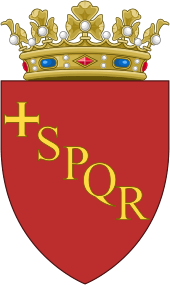
Rome – capital of Italy and a special comune (named Comune di Roma Capitale). Rome also serves as the capital of the Lazio region. With 2,876,076 residents in 1,285 km2 (496.1 sq mi), it is also the country's most populated comune. It is the fourth-most populous city in the European Union by population within city limits. It is the center of the Metropolitan City of Rome, which has a population of 4.3 million residents. Rome is located in the central-western portion of the Italian Peninsula, within Lazio (Latium), along the shores of the Tiber.
The Vatican City is an independent city-state enclaved within Rome, the only existing example of a state within a city: for this reason, Rome has been often defined as the capital of two states. Rome is a very old city, founded over 28 centuries ago, and it was the center of power of the ancient Roman civilization.
General reference
- Pronunciation: /ˈroʊm/ ROHM; Italian: Roma [ˈroːma] (

- Common English name(s): Rome
- Official English name(s): City of Rome
- Adjectival(s): Roman
- Demonym(s): Roman
Geography of Rome
Geography of Rome
- Rome is:
- Population of Rome: 2,873,494
- Area of Rome:
- Atlas of Rome
- Topography of ancient Rome
Location of Rome
- Rome is situated within the following regions:
- Time zone(s): Central European Time (UTC+01), Central European Summer Time (UTC+02)
Environment of Rome
- Climate of Rome
- Climate of Ancient Rome
Landforms of Rome
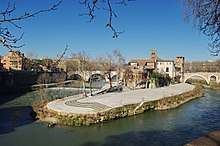
- Hills in Rome
- Janiculum – second tallest hill in Rome.
- Monte Mario – highest hill in Rome.
- Monte Sacro
- Monte Testaccio
- Parioli
- Pincian Hill
- Seven hills of Rome
- Aventine Hill (Latin, Aventinus; Italian, Aventino)
- Caelian Hill (Cælius, Celio)
- Capitoline Hill (Capitolinus, Campidoglio)
- Esquiline Hill (Esquilinus, Esquilino)
- Palatine Hill (Palatinus, Palatino)
- Quirinal Hill (Quirinalis, Quirinale)
- Viminal Hill (Viminalis, Viminale)
- Vatican Hill
- Velian Hill
- Islands of Rome
- Rivers in Rome
Areas of Rome
- Ager Romanus
- Areas within Rome that are not actually part of Rome
- Vatican City (outline) – only example of a country inside a city. The sovereign territory of the Holy See of the Catholic Church.
- Seven hills of Rome
Administrative subdivisions of Rome
Administrative subdivisions of Rome
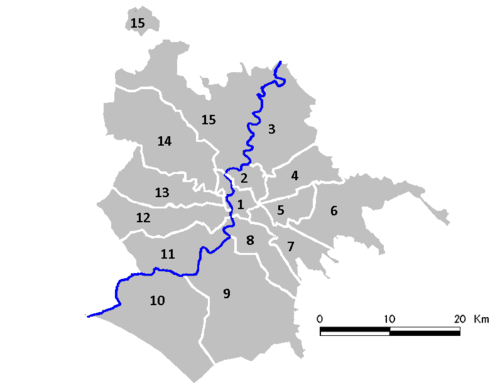
- Municipi of Rome
- Municipio I - Historical Center-Prati
- Municipio II - Parioli/Nomentano-San Lorenzo
- Municipio III - Monte Sacro
- Municipio IV - Tiburtina
- Municipio IX - EUR
- Municipio V - Prenestino/Centocelle
- Municipio VI - Roma Delle Torri
- Municipio VII - San Giovanni/Cinecittà
- Municipio VIII - Appia Antica
- Municipio X - Ostia
- Municipio XI - Arvalia Portuense
- Municipio XII - Monte Verde
- Municipio XIII - Aurelia
- Municipio XIV - Monte Mario
- Municipio XV - Cassia Flaminia
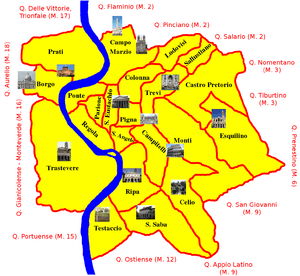
- Rioni of Rome
- Borgo – lies next to Vatican City
- Campitelli – includes the Hills of Capitol and Palatine
- Campo Marzio
- Castro Pretorio
- Celio – includes Hill
- Colonna
- Esquilino – includes Esquiline Hill
- Ludovisi
- Monti – includes the Hills of Quirinal and Viminal
- Parione
- Pigna
- Ponte
- Prati
- Regola
- Ripa – includes the Hill of Aventine
- Sallustiano
- San Saba
- Sant'Angelo
- Sant'Eustachio
- Testaccio
- Trastevere – includes the so-called "8th Roman Hill" of the Gianicolo
- Trevi
Locations in Rome
Ancient monuments in Rome
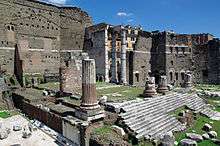
.jpg)
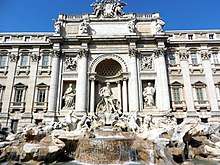
.jpg)

- Amphitheatrum Castrense
- Ara Pacis
- Aqueducts in the city of Rome
- Ancient obelisks in Rome
- Ancient temples in Rome
- Ancient triumphal arches in Rome
- Ancient villas in Rome
- Altare della Patria
- Aurelian Walls
- Baths of Caracalla
- Baths of Trajan
- Castel Sant'Angelo
- Circus Maximus
- Colosseum
- Column of Marcus Aurelius
- Comitium
- Domus Aurea
- Domus Transitoria
- Equestrian Statue of Marcus Aurelius
- Forum Boarium
- Forum of Augustus
- Gardens of Maecenas
- House of Augustus
- Imperial fora
- Ludus Magnus
- Mausoleum of Augustus
- Monument to Garibaldi
- Porta del Popolo
- Porta San Giovanni
- Pyramid of Cestius
- Roman Forum
- Sant'Omobono Area
- Servian Wall
- Spanish Steps
- Stadium of Domitian
- Theatre of Marcellus
- Theatre of Pompey
- Tomb of Eurysaces the Baker
- Torre dei Capocci
- Torre delle Milizie
- Trajan's Column
- Trajan's Market
- Villa Farnese
Bridges in Rome
Catacombs
Churches in Rome
Basilicas and churches of Rome
- St. Peter's Basilica
- Archbasilica of Saint John Lateran
- Basilica of San Clemente al Laterano
- Basilica di Santa Maria Maggiore
- Basilica of Santa Maria in Ara Coeli
- Basilica of Saint Paul Outside the Walls
- Church of the Gesù
- San Carlo alle Quattro Fontane
- Santa Croce in Gerusalemme
- Santa Maria degli Angeli e dei Martiri
- Santa Maria in Cosmedin
- Santa Maria in Trastevere
- Santa Prassede
- Santa Sabina
- Sant'Ivo alla Sapienza
- Santa Maria della Vittoria
- Santa Maria del Popolo
- San Pietro in Vincoli
Fountains in Rome
Museums in Rome
Palaces in Rome
Palaces in Rome
Parks and gardens in Rome
Public squares in Rome
Piazzas in Rome
Streets of Rome
- Appian Way
- Clivus Capitolinus
- Lungoteveres in Rome
- Lungotevere on the right bank of the Tiber
- Lungotevere Maresciallo Diaz
- Lungotevere Maresciallo Cadorna
- Lungotevere Della Vittoria
- Lungotevere Guglielmo Oberdan
- Lungotevere delle Armi
- Lungotevere Michelangelo
- Lungotevere dei Mellini
- Lungotevere Prati
- Lungotevere Castello
- Lungotevere Vaticano
- Lungotevere in Sassia
- Lungotevere Gianicolense
- Lungotevere della Farnesina
- Lungotevere Raffaello Sanzio
- Lungotevere degli Anguillara
- Lungotevere degli Alberteschi
- Lungotevere Ripa
- Lungotevere Portuense
- Lungotevere degli Artigiani
- Lungotevere Vittorio Gassman
- Lungotevere di Pietra Papa
- Lungotevere degli Inventori
- Lungotevere della Magliana
- Lungotevere on the left bank of the Tiber
- Lungotevere dell'Acqua Acetosa
- Lungotevere Salvo D'Acquisto
- Lungotevere Grande Ammiraglio Thaon di Revel
- Lungotevere Flaminio
- Lungotevere delle Navi
- Lungotevere Arnaldo da Brescia
- Lungotevere in Augusta
- Lungotevere Marzio
- Lungotevere Tor di Nona
- Lungotevere degli Altoviti
- Lungotevere dei Fiorentini
- Lungotevere dei Sangallo
- Lungotevere dei Tebaldi
- Lungotevere dei Vallati
- Lungotevere De' Cenci
- Lungotevere dei Pierleoni
- Lungotevere Aventino
- Lungotevere Testaccio
- Lungotevere di San Paolo
- Lungotevere Dante
- Lungotevere on the right bank of the Tiber
- Via Condotti
- Via del Corso
- Via della Conciliazione
- Via dei Coronari
- Via dei Fori Imperiali
- Via Nazionale
- Via Sacra
- Via Veneto
Demographics of Rome
Demographics of Rome
Government and politics of Rome
_September_2015-1.jpg)
Government of Rome
Law and order in Rome
Military in Rome
- Granatieri di Sardegna Mechanized Brigade
History of Rome
History of Rome, by period or event
- Rome during the Roman Kingdom (c. 753-509 BC)
- Founding of Rome (circa 752 BC)
- Founding myth: Romulus and Remus
- Overthrow of the Roman monarchy (509 BC) – expulsion of the last king of Rome, Lucius Tarquinius Superbus, and the establishment of the Roman Republic.
- Founding of Rome (circa 752 BC)
- Rome during the Roman Republic (509-27 BC)
- Siege of Rome (508 BC) – Rome is besieged by the city of Clusium
- Sack of Rome (390 BC) – Rome is sacked by the Senones, after the Battle of the Allia
- Rise of Rome (circa 100 BC to the 4th century AD)
- Rome during the Roman Empire (27 BC-285 AD)
- Rome during the Western Roman Empire (285-476AD)
- Sack of Rome (410) – Rome is besieged and sacked by Alaric, King of the Visigoths
- Sack of Rome (455) – Rome is besieged and sacked by Genseric, King of the Vandals
- Deposition of Romulus Augustulus (476) – marked the end of the Western Roman Empire, and the beginning of the European Middle Ages
- Rome during the Kingdom of Odoacer (476–493)
- Rome during the Ostrogothic Kingdom (493–553)
- Siege of Rome (537–538) – Belisarius defends the city against the Ostrogoths
- Siege of Rome (546) – Rome is besieged, sacked and depopulated by Totila, King of the Ostrogoths, Rome during the Gothic War
- Siege of Rome (549–550) – Rome is besieged and captured by Totila, King of the Ostrogoths, Rome during the Gothic War
- Rome during the Eastern Roman Empire (553–754)
- Rome during the Papal States (754–1870)
- Siege of Rome (756) – Rome is besieged by the Lombard prince Aistulf
- Arab raid against Rome (846) – Saracen raiders plundered the outskirts of the city of Rome, sacking the basilicas of Old St Peter's and St Paul's-Outside-the-Walls, but were prevented from entering the city itself by the Aurelian Wall.
- Sack of Rome (1084) – Rome is sacked by the Normans under Robert Guiscard
- Roman Renaissance – mid-15th to the mid-16th centuries
- Banquet of Chestnuts
- Sack of Rome (1527) – Rome is sacked by the mutinous troops of Charles V, Holy Roman Emperor, marking the end of the Roman Renaissance.
- Annexation of Rome by France – the French invaded, under the rule of Napoleon Bonaparte, establishing the Department of Rome. Rome became a canton within the Arrondissement of Rome.
- Siege of Rome (1849) – Rome is besieged by French Second Republic forces Rome during the short-lived Roman Republic
- Rome during the Kingdom of Italy (1870–1946)
- Capture of Rome – Rome was captured by Italian forces in September 1870, ending the Risorgimento, and establishing Rome as the capital of the Kingdom of Italy. It marked both the final defeat of the Papal States under Pope Pius IX and the unification of the Italian peninsula under King Victor Emmanuel II of the House of Savoy.
- Lateran Treaty – treaty signed between Italy and the Catholic Church in 1929. It settled the Roman Question, established the Holy See as a sovereign entity, and recognized Vatican City as an independent state and the sovereign territory of the Holy See, within Rome.
- Holy See – headquartered in its sovereign territory, Vatican City.
- Vatican City (outline) – established in 1929 in the Lateran Treaty as the sovereign territory of the Holy See. It becomes an enclave, within Rome.
- Rome during the Italian Republic (1946–present)
History of Rome, by subject
- List of popes
- History of sports in Rome
- History of racing in Rome
Culture in Rome

.jpg)
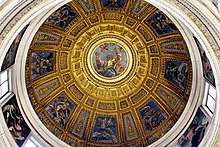


.jpg)
Culture of Rome
- Culture of ancient Rome
- Cuisine of Rome
- Events in Rome
- Language of Rome
- People from Rome
Arts in Rome
- Roman art
- Ancient Roman pottery
- Roman portraiture
- Roman sculpture
- Roman wall painting (200 BC–AD 79)
- Rome-themed paintings
- Roman Renaissance
- Scuola Romana
- Prix de Rome
- Rome Quadriennale
- Rome Prize
Architecture of Rome
- Ancient Roman architecture
- Fascist architecture in Rome
- EUR, Rome (Esposizione Universale Roma) – Construction of the EUR began in 1936 in anticipation for Mussolini's World Fair in 1942 to mark the 20th anniversary of the Italian fascist era
- Palazzo della Civiltà Italiana – A famous edifice of the EUR
- Tallest buildings in Rome
Cinema of Rome
Cinema of Rome
Music of Rome
Music of Rome
Religion in Rome
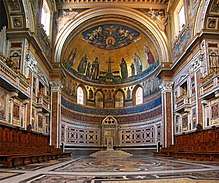
- Religion in ancient Rome
- Catholicism in Rome
- Pope (Bishop of Rome)
- Primacy of the Bishop of Rome
- Diocese of Rome
- National churches in Rome
- Pope (Bishop of Rome)
- Islam in Rome
- Roman mythology
Churches in Rome
- Seven Pilgrim Churches of Rome
- Titular churches in Rome
Sports in Rome
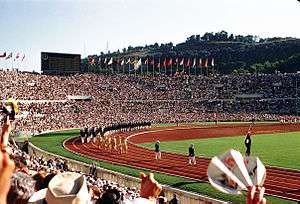
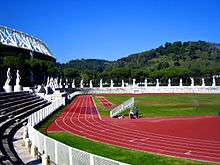
Sports in Rome
- Basketball in Rome
- Pallacanestro Virtus Roma
- Football in Rome
- Association football in Rome
- Rugby football in Rome
- Olympics in Rome
- Running in Rome
- Sports venues in Rome
- Tennis in Rome
Economy and infrastructure of Rome

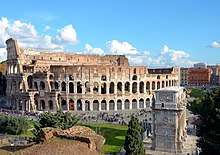
- Communication in Rome
- Fashion industry in Rome
- Hotels in Rome
- Aldrovandi Villa Borghese
- Boscolo Exedra Roma
- Hotel d'Inghilterra
- The Westin Excelsior Rome
- Restaurants and cafés in Rome
- Tourism in Rome
Transportation in Rome

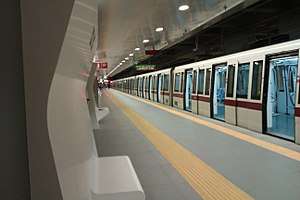
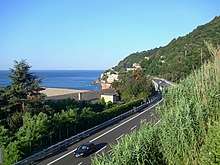
Airports in Rome
Rail transport in Rome
Road transport in Rome
Education in Rome
.jpg)
Education in Rome
- Education in ancient Rome
- Italian universities in Rome
- Sapienza University of Rome – founded in 1303
- University of Rome Tor Vergata – founded in 1982
- Roma Tre University – founded in 1992
- Foro Italico University of Rome – founded in 1998
- Link Campus University
- Libera Università Internazionale degli Studi Sociali Guido Carli
- S. Pio V University of Rome
- Libera Università Maria SS. Assunta
- Università Campus Bio-Medico
- Università degli Studi Niccolò Cusano
- Marconi University
- Other colleges in Rome
- Roman Colleges
Healthcare in Rome
Hospitals in Rome
See also
References
- Names of European cities in different languages: Q–T#R
External links
- Comune of Rome (in Italian)
- APT (official Tourist Office) of the City of Rome (in English)
- Rome Museums – Official site (in English)
- Capitoline Museums (in English)

